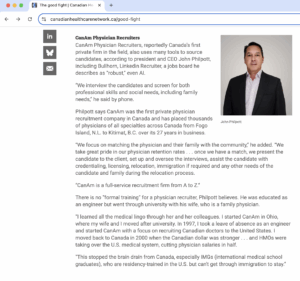 Our CEO, John Philpott, recently sat down with Matt Borsellino for an interview featured in Canadian Healthcare Network’s article The Good Fight – Physician recruiters getting more sophisticated as environment they face getting more complex. The conversation shed light on the evolving world of physician recruitment and the unique challenges Canada faces in ensuring access to healthcare professionals.
Our CEO, John Philpott, recently sat down with Matt Borsellino for an interview featured in Canadian Healthcare Network’s article The Good Fight – Physician recruiters getting more sophisticated as environment they face getting more complex. The conversation shed light on the evolving world of physician recruitment and the unique challenges Canada faces in ensuring access to healthcare professionals.
Below, we highlight four key issues discussed in the interview — and John’s insights on how CanAm Physician Recruiters continues to address them.
1. Competition Among Physician Recruiters
Q: How would you describe the current level of competition among physician recruiters?
John Philpott: “All CaSPR members are in competition. CanAm works all across Canada, so we have the great luxury of discussing all opportunities across Canada and we can up and down sell opportunities.
Imagine you’re a doctor from the U.K. talking to a CaSPR in-house recruiter in a small region of Canada. The candidate wants to know what else might be available across Canada. A CaSPR member can’t discuss that, but CanAm can.”
Takeaway: CanAm’s national reach and flexibility give international and Canadian-trained physicians a broader view of opportunities, ensuring the right fit for both candidates and communities.
2. International Recruitment as a Necessity
Q: Is it necessary for Canada to increase its reliance on what’s going on outside the country if it wants to achieve a sufficient supply of physicians?
Philpott: “Absolutely! Canada does not train the best doctors. Family medicine residency in Canada is only two years. In every other country it is three or four years. Dalhousie medical school was even on WHO’s probationary list in 2009. In 2017, it was fully-accredited for an eight-year term.”
Takeaway: With Canada’s shorter training timelines and limited physician output, international recruitment is not just an option—it’s essential to meet growing demand.
3. Physician Supply Across Regions
Q: How would you describe your regional responsibility in terms of physician supply?
Philpott: “Family practitioners are needed everywhere, and there will never be an oversupply. Specialists will be in demand regularly given the average age of a specialist in Canada is now over 60.”
Takeaway: No region is immune from shortages. Family physicians remain universally in demand, while an aging specialist workforce means recruitment efforts must be ongoing and strategic.
4. Government Collaboration and Bureaucracy
Q: How would you describe the level of co-operation you’ve received from local and provincial governments?
Philpott: “Premiers and ministers of health are all very serious about recruitment and retention, but they are bound by bureaucracy within government. This is a major problem.
CanAm works best when we work directly with decision-makers, such as chiefs of clinical departments and medical directors. Over the years, we’ve seen government health departments implode with bureaucracy—especially when provincial governments consolidate health boards. Nova Scotia is a great example, moving from nine boards down to one, creating one of the worst healthcare systems in the country with some of the longest waiting lists. We’ve seen similar situations in Saskatchewan, Manitoba and Newfoundland and Labrador.”
Takeaway: Direct collaboration with clinical leaders often produces better results than navigating government bureaucracy. Efficiency in decision-making is critical to improving physician recruitment and retention.
Looking Ahead
CanAm Physician Recruiters has been leading the way in Canada for over 27 years, placing thousands of physicians across the country. As the environment grows increasingly complex, our mission remains the same: to match the right physician with the right community while supporting both through the entire process—from licensing to relocation.
We are proud to be at the forefront of this “good fight,” ensuring Canadians have access to the healthcare providers they need, when and where they need them.

